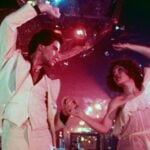Carlo_M
Senior HTF Member
- Joined
- Oct 31, 1997
- Messages
- 13,392
DISCLAIMER
This post was made partially in jest (or at least in good humor) based on a throwaway comment I made when looking at the different aspect ratios of Dune and various other partially (or fully) shot in IMAX films. One could watch them on a fixed 2.40:1 aspect ratio in a cinema, or in the "in-between" IMAX screen of 1.90:1, or in the full 1.43:1 IMAX screen for the few in the country that have that.
JACK HANDY'S DEEP THOUGHTS (SNL reference that only those over 40 will get)
As a child of the 1980s I wasn't around when Academy ratio was the standard for Hollywood movies. As I began to get more into film, one of the common things I heard was that Hollywood (and filmmakers in general) migrated to widescreen aspect ratios to get people back to the theaters because they were largely staying home, where TVs had become ubiquitous and had the same aspect ratio (1.33:1) as Academy ratio films.
Being a long-time member of HTF, I recall all the difficulty we had in the late 1990s explaining to our non-HTF friends that the black bars didn't actually take away picture, but added it! (Let's not wade into the territory of open matte films for which this statement did not always hold true).
Well 25 years later, and now widescreen TVs are the norm. It got me thinking. Is IMAX's 1.43:1 ratio (surprisingly close to Academy ratio) the new attempt to "get us back into the cinemas"?
And yes, I know the answer can only be "No" because there are relatively few true 1.43:1 IMAX screens in the US, and I don't get the sense that there's going to be a mass change of screens to 1.43:1 in the near (or far) future. And yes I also get that if one uses true IMAX cameras and film (as Nolan does) there are many more benefits outside of aspect ratio, such as the greater resolution of that type of film.
But it just struck me as a little funny that we went from 1.33:1 to 1.85/2.40:1 (yes I realize there's many more aspect ratios, I'm just choosing the two most common modern ones). And now we seem to be going backwards. Maybe someone should try shooting a film in a trapezoid shape!
This post was made partially in jest (or at least in good humor) based on a throwaway comment I made when looking at the different aspect ratios of Dune and various other partially (or fully) shot in IMAX films. One could watch them on a fixed 2.40:1 aspect ratio in a cinema, or in the "in-between" IMAX screen of 1.90:1, or in the full 1.43:1 IMAX screen for the few in the country that have that.
JACK HANDY'S DEEP THOUGHTS (SNL reference that only those over 40 will get)
As a child of the 1980s I wasn't around when Academy ratio was the standard for Hollywood movies. As I began to get more into film, one of the common things I heard was that Hollywood (and filmmakers in general) migrated to widescreen aspect ratios to get people back to the theaters because they were largely staying home, where TVs had become ubiquitous and had the same aspect ratio (1.33:1) as Academy ratio films.
Being a long-time member of HTF, I recall all the difficulty we had in the late 1990s explaining to our non-HTF friends that the black bars didn't actually take away picture, but added it! (Let's not wade into the territory of open matte films for which this statement did not always hold true).
Well 25 years later, and now widescreen TVs are the norm. It got me thinking. Is IMAX's 1.43:1 ratio (surprisingly close to Academy ratio) the new attempt to "get us back into the cinemas"?
And yes, I know the answer can only be "No" because there are relatively few true 1.43:1 IMAX screens in the US, and I don't get the sense that there's going to be a mass change of screens to 1.43:1 in the near (or far) future. And yes I also get that if one uses true IMAX cameras and film (as Nolan does) there are many more benefits outside of aspect ratio, such as the greater resolution of that type of film.
But it just struck me as a little funny that we went from 1.33:1 to 1.85/2.40:1 (yes I realize there's many more aspect ratios, I'm just choosing the two most common modern ones). And now we seem to be going backwards. Maybe someone should try shooting a film in a trapezoid shape!





